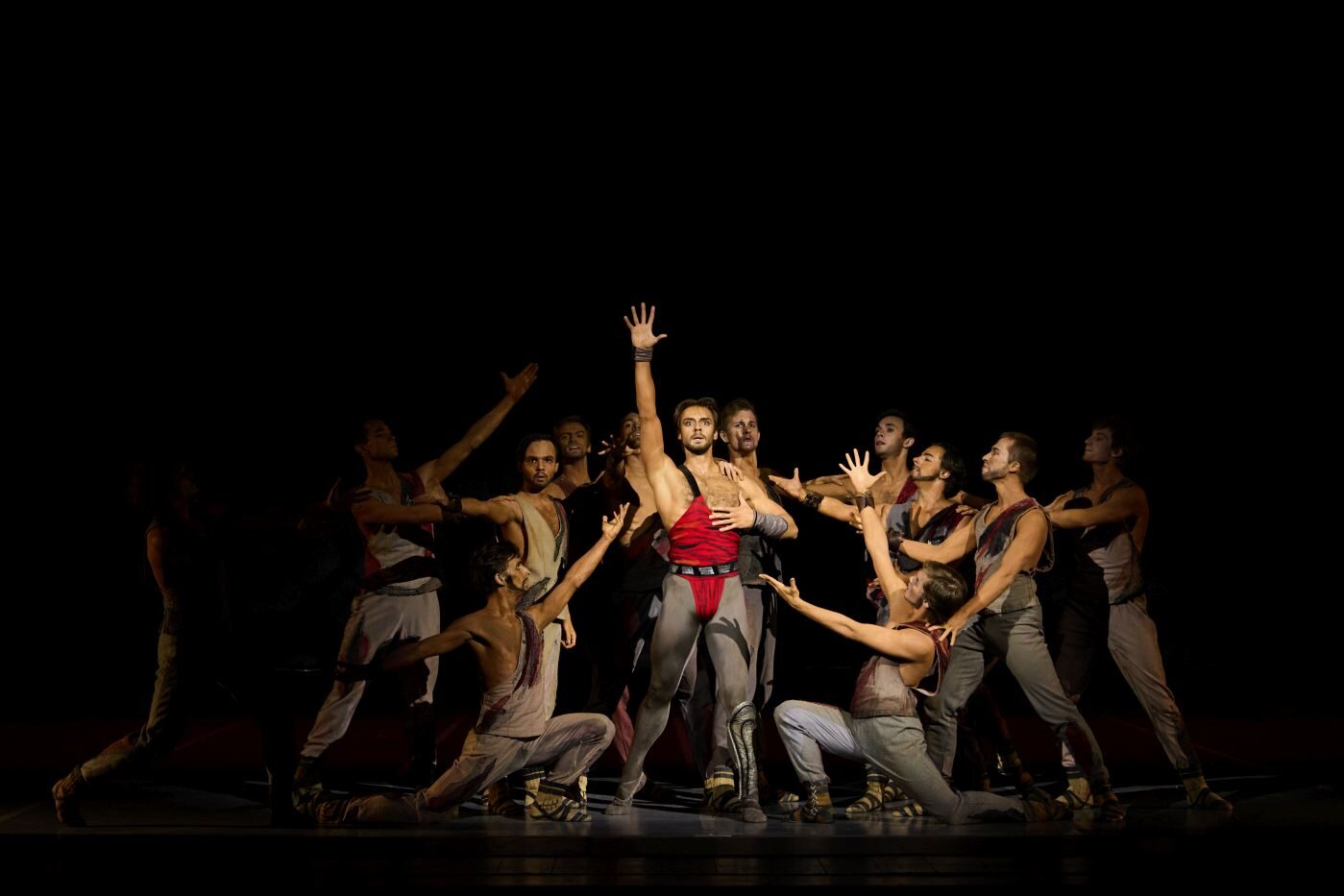“Alvin Ailey American Dance Theater”
Deutsches Theater
Munich, Germany
August 22, 2017
by Ilona Landgraf
Copyright © 2017 by Ilona Landgraf
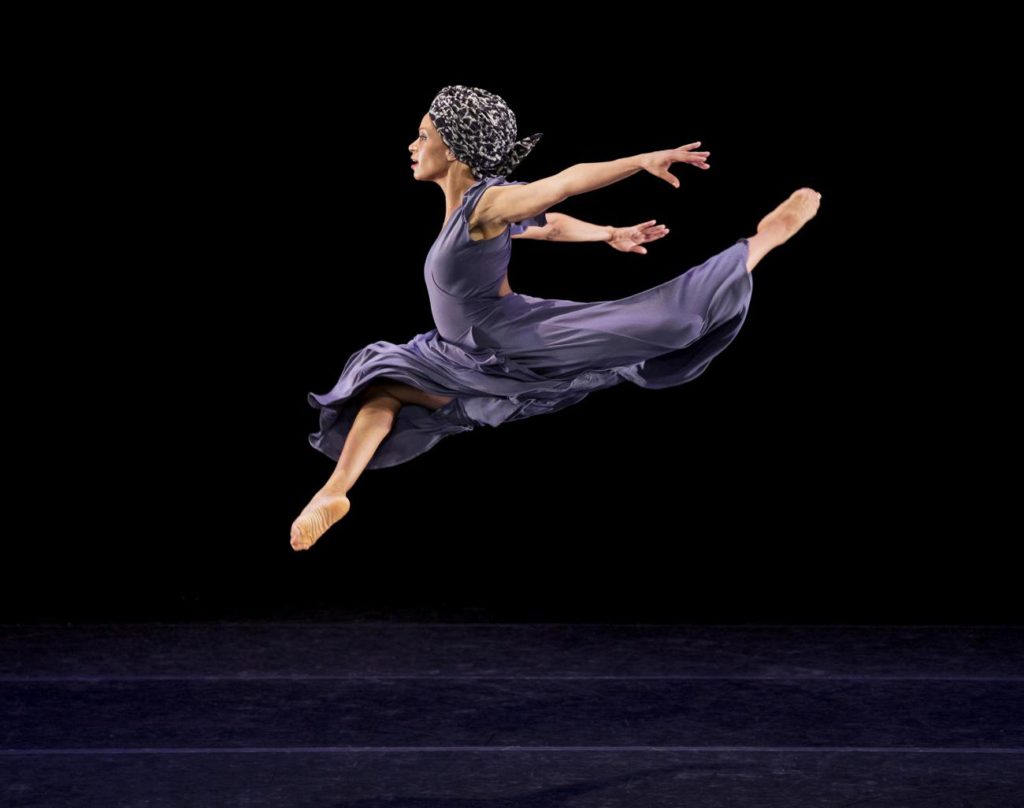 The summer tour of the Alvin Ailey company kicked off in Paris and, after one week in Basel, reached Germany in early August where the main body of performances was scheduled. The last stop will be in Copenhagen in September.
The summer tour of the Alvin Ailey company kicked off in Paris and, after one week in Basel, reached Germany in early August where the main body of performances was scheduled. The last stop will be in Copenhagen in September.
I saw the opening night in Munich, one of the five cities on the troupe’s German itinerary. The four pieces on the program included “Four Corners” by Ronald K. Brown, “Exodus” by Rennie Harris, Robert Battle’s short “Takademe” and the company’s signature piece “Revelations,” one of the Ailey’s earliest works. He created it in 1960 when he was just twenty-nine-year-old. “Four Corners” and “Exodus” were replaced by “Open Door” and “Piazzolla Caldera” at other venues on the tour.
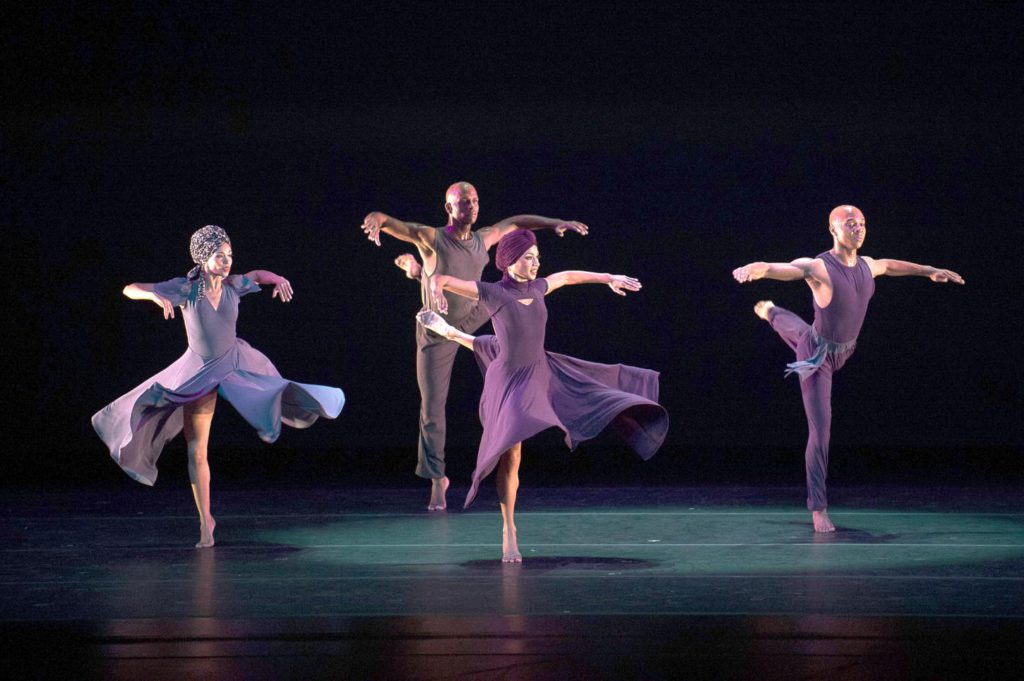 Four angels standing at the corners of the earth and holding the four winds give “Four Corners” its title. But it was difficult to discern which of the eleven dancers involved depicted the four angels. Maybe the two women and two men, dancing in a square dance style grouping? Omotayo Wunmi Olaiya’s costumes in purple, blue, gray and combined with black and white patterns didn’t highlight the angels. Brown drew inspiration from the song “Lamentations” by Carl Hancock Rux which next to music by Rahsaan Roland Kirk and pulsing rhythms by Yacoub served as accompaniment. Yet the atmosphere wasn’t as somber as his lyrics for “Lamentations” lead one to expect. Wreathed in mist, the stage was lit by rays of light that seemed to shine through some shutters out in the right wing. Several
Four angels standing at the corners of the earth and holding the four winds give “Four Corners” its title. But it was difficult to discern which of the eleven dancers involved depicted the four angels. Maybe the two women and two men, dancing in a square dance style grouping? Omotayo Wunmi Olaiya’s costumes in purple, blue, gray and combined with black and white patterns didn’t highlight the angels. Brown drew inspiration from the song “Lamentations” by Carl Hancock Rux which next to music by Rahsaan Roland Kirk and pulsing rhythms by Yacoub served as accompaniment. Yet the atmosphere wasn’t as somber as his lyrics for “Lamentations” lead one to expect. Wreathed in mist, the stage was lit by rays of light that seemed to shine through some shutters out in the right wing. Several 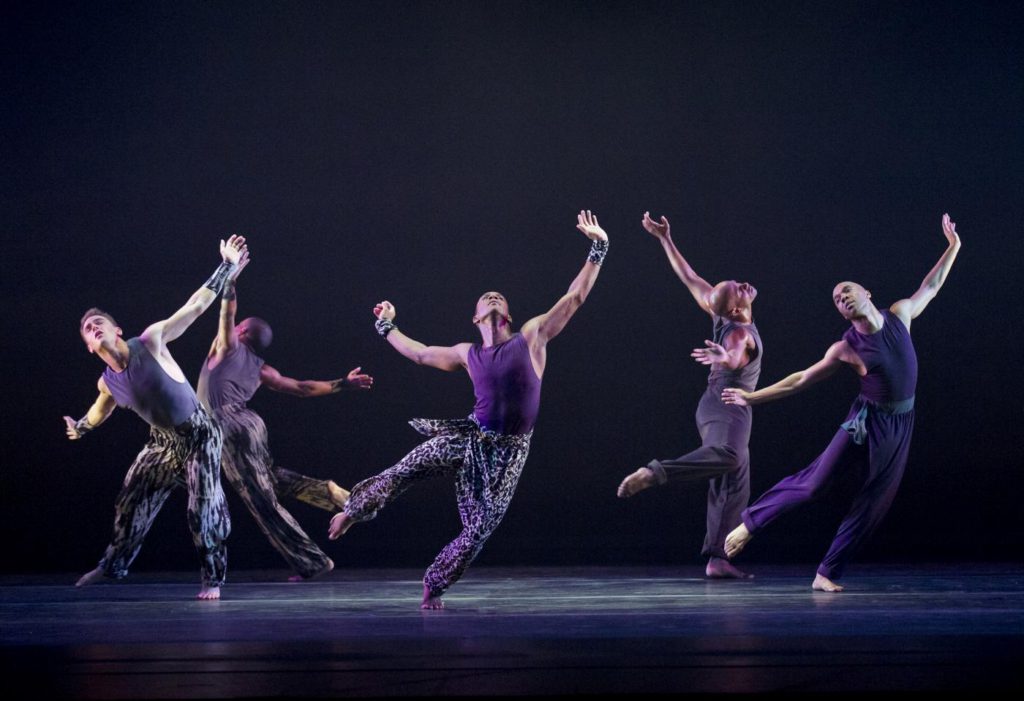 times dancers turned towards the light as if it was a source of special meaning. Precise, almost geometrical arm movements contrasted with wavy upper body undulations and loose turns. Was the brief folding of hands a gesture of praying? And did the man and the squatting women surrounding him perform a ritual?
times dancers turned towards the light as if it was a source of special meaning. Precise, almost geometrical arm movements contrasted with wavy upper body undulations and loose turns. Was the brief folding of hands a gesture of praying? And did the man and the squatting women surrounding him perform a ritual?
At other moments the women defiantly thrust out their hips, gathered their skirts and stepped determinedly forward, their feet flexed, as if pouring themselves into domestic work. Movements were rhythmic, fluent and repetitive, characterized by waves, which seemed to ripple through torsos and arms. Altogether, arms were expressive tools. They reached out, stretched yearningly, swung, pointed interrogatively towards the audience and, even when crossed behind the dancers’ 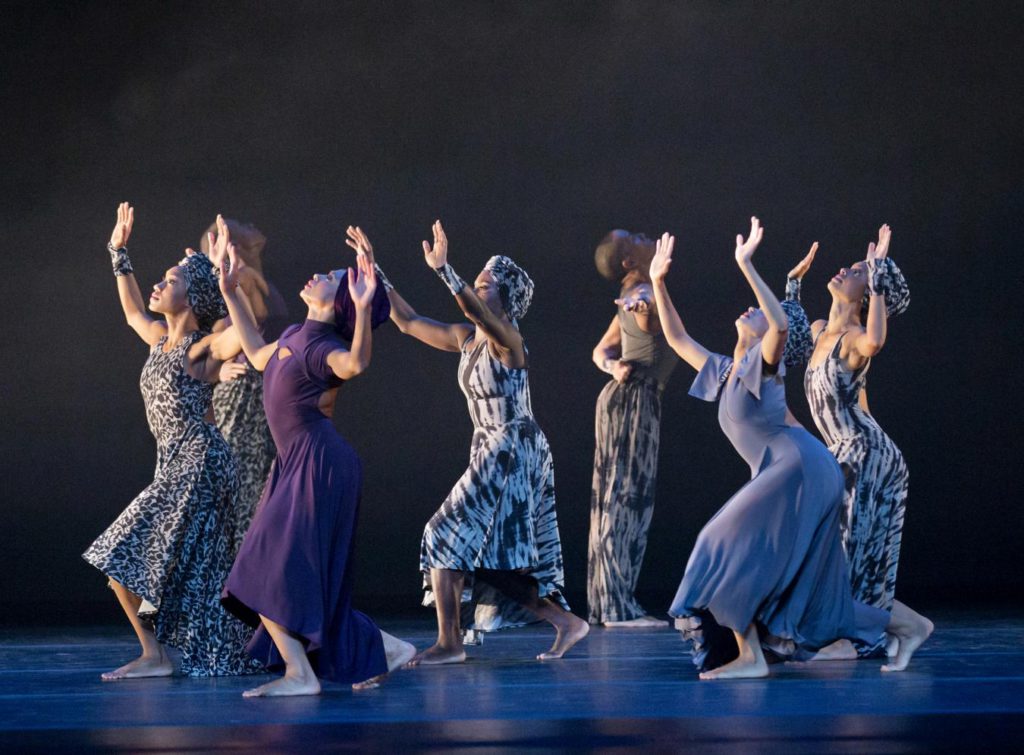 backs, the shoulders shook in time with the music. “Four Corners” gained momentum the moment three men swung their hips and arms to pushing and rattling percussion. Towards the end, the dancers raised their arms as if gathering energy from above which their feet then worked into the floor. It looked like a ritual to prepare the stage.
backs, the shoulders shook in time with the music. “Four Corners” gained momentum the moment three men swung their hips and arms to pushing and rattling percussion. Towards the end, the dancers raised their arms as if gathering energy from above which their feet then worked into the floor. It looked like a ritual to prepare the stage.
Talking about the making of “Exodus,” choreographer Rennie Harris revealed in a video that it was about his mother, who had just passed away one day before his birthday in 2015. It is about the “spirit moving on,” about “how we do transition from this place we are in right now.” But the piece also addresses political and social issues. Harris is a hip hop choreographer and, said the company’s artistic director Robert Battle in the same video, “Hip hop being something that was a celebration of life, but also in some ways a way of protesting, a way of […] reclaiming our drums. It comes from the street; it comes from those kinds of experiences and frustrations”.
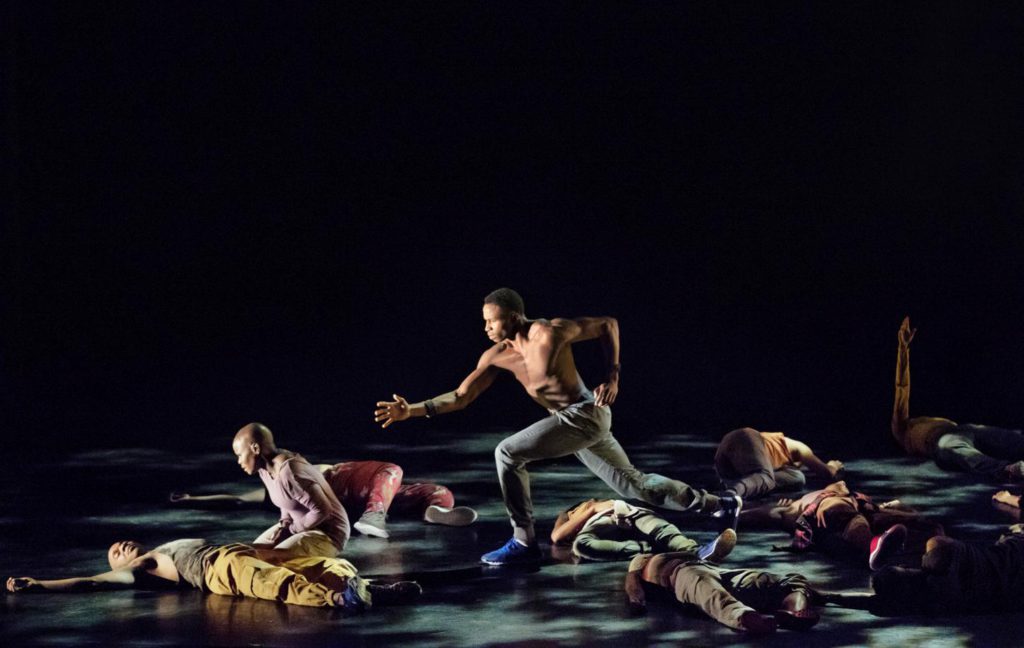 Again, the stage was covered by mist at the beginning. Rays of light this time shone from above. Except for two dancers all others lay motionless on the ground, making one think of corpses of a war, but on the loudspeakers a recorded voice talked about exploring the mind, so maybe the mourning music (credited to Raphael Xavier) was directed towards another kind of dying than that on a literal battlefield. The two dancers depicting living creatures were a short woman (Hope Boykin), who mourned a lifeless man, and a tall, muscular man (Jamar Roberts). He was an ambiguous figure, bringing life, but also death. On the one hand he consoled Boykin and, in a state of spiritual trembling, reawakened the dead ones who one after the other rose from the
Again, the stage was covered by mist at the beginning. Rays of light this time shone from above. Except for two dancers all others lay motionless on the ground, making one think of corpses of a war, but on the loudspeakers a recorded voice talked about exploring the mind, so maybe the mourning music (credited to Raphael Xavier) was directed towards another kind of dying than that on a literal battlefield. The two dancers depicting living creatures were a short woman (Hope Boykin), who mourned a lifeless man, and a tall, muscular man (Jamar Roberts). He was an ambiguous figure, bringing life, but also death. On the one hand he consoled Boykin and, in a state of spiritual trembling, reawakened the dead ones who one after the other rose from the 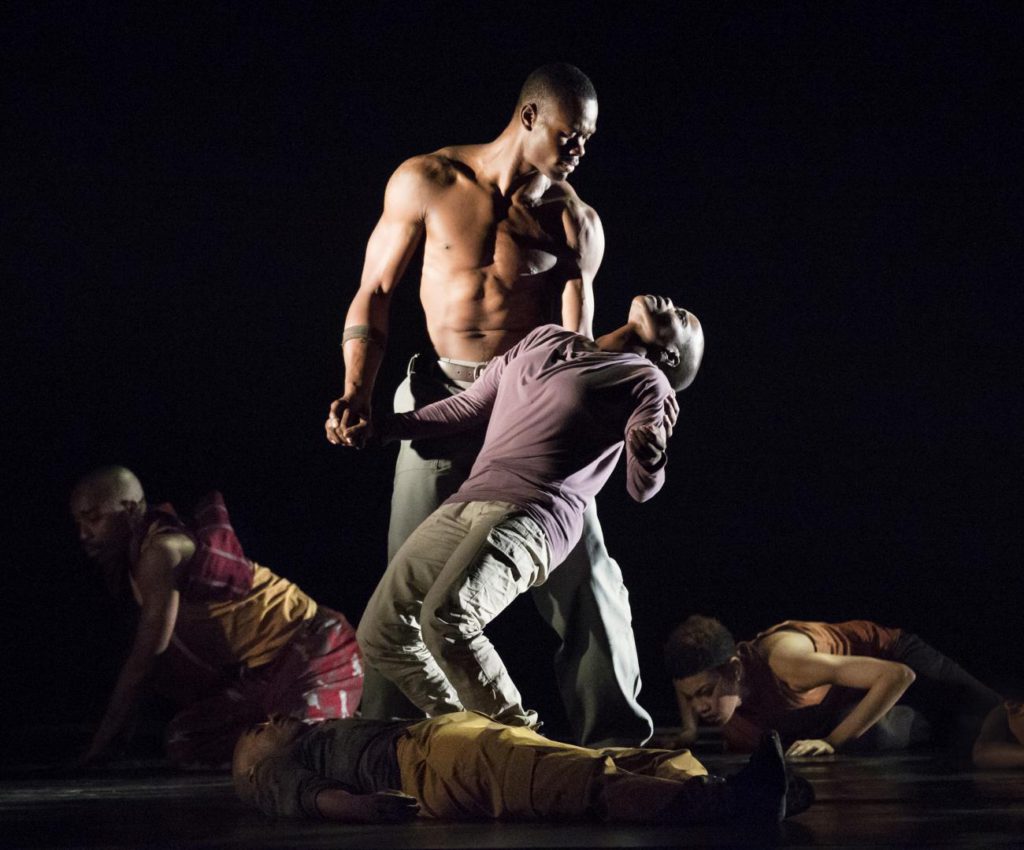 ground. On the other hand he radiated daunting authority and power. In a later scene he positioned a shorter man in front of him (a human shield?), who then collapsed as if shot dead which caused one woman of the group – his wife or girlfriend – to cry desperately.
ground. On the other hand he radiated daunting authority and power. In a later scene he positioned a shorter man in front of him (a human shield?), who then collapsed as if shot dead which caused one woman of the group – his wife or girlfriend – to cry desperately.
The reawakened ones, apparently in another, unfamiliar state of being, stood passively around before starting to tremble as if their entire bodies were charged with electricity. One woman who had stepped out of the group and stretched her arms frantically was calmed by others. Then more and more hip hop moves occurred. Hips were thrust, hands clapped, movements got rubbery-elastic and loose, quickening to an almost hectic speed. Formerly dressed in casual clothes the dancers later returned in white pants and long white shirts that indicated their transformed state of being (costumes by Jon Taylor). Compared to the piece’s heavily meaningful beginning, their dance routine (set to “A New Deal” by 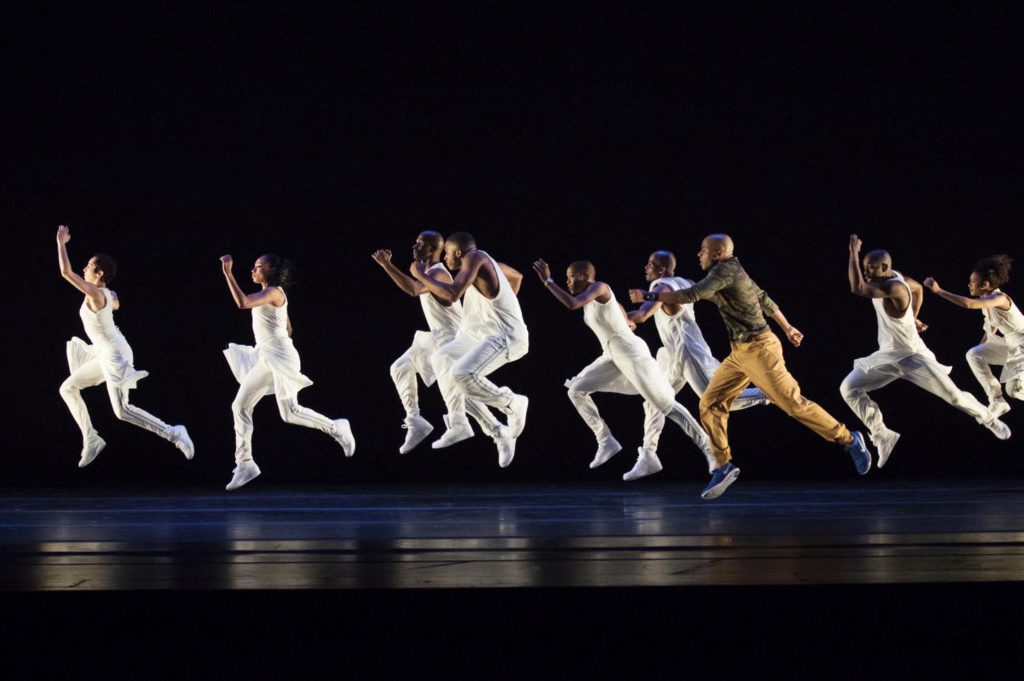 the Norwegian duo Ost & Kjex), though expertly delivered, got a bit lengthy.
the Norwegian duo Ost & Kjex), though expertly delivered, got a bit lengthy.
“Exodus” ended puzzlingly. At the curtain call Roberts stood in the middle of the line of dancers. No one smiled. Instead, grief, disapproval and even disgust suddenly spread across the faces. They turned round, ditched Roberts and, facing away, assembled in the back of the stage.
“Takademe” is a witty three-minute solo that Battle choreographed for the company in 1999, long before taking over as director in 2011. It had Yannik Lebrun translate into movement what vocalist Sheila Chandra sang. Her “Speaking in Tongues II” is a monolog apparently turning around “din” – and whatever that meant, 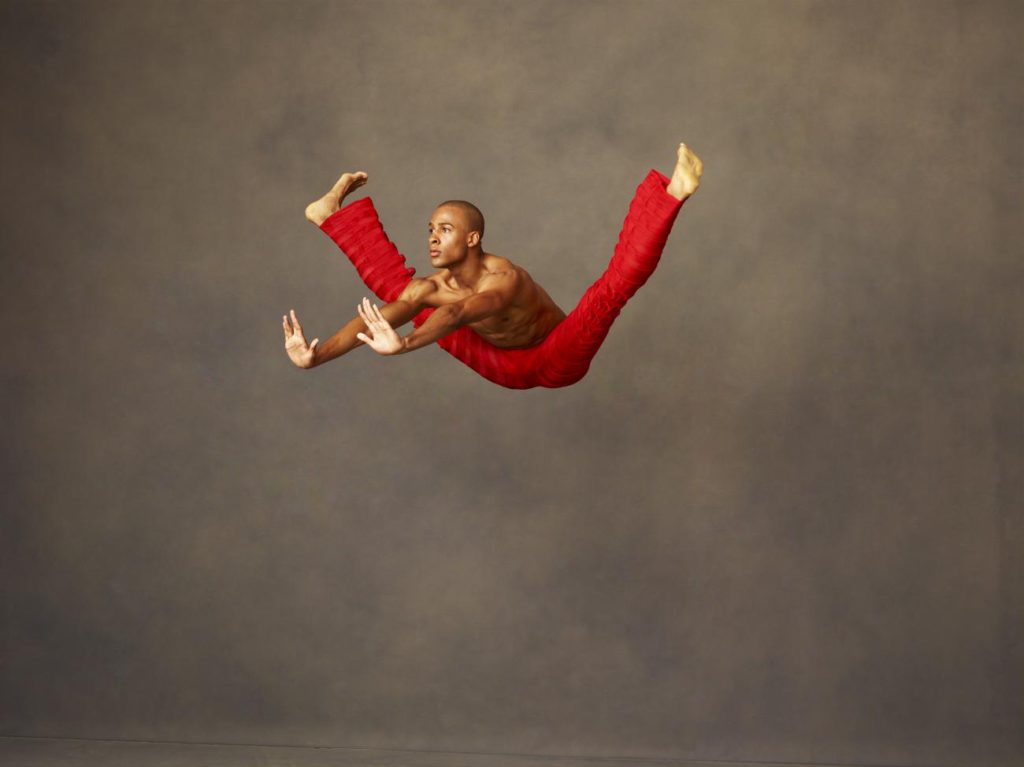 she talked vividly about it. Lebrun, his head tilted, glanced wide eyed towards the audience, as if they knew the answer to what sounded like a question in Chandra’s stream of sounds. Her slow exhalation caused his upper body to bend forward as if he wanted to squeeze the air out of an accordion held vertically. Lebrun swiftly swung and swirled his arms, hopped, jumped, stepped around on his heels to match the pace and temper of Chandra’s vocalizing, but, given the lightning speed the flood of sounds reached, it was no wonder that he held his head and finally collapsed flat to the floor.
she talked vividly about it. Lebrun, his head tilted, glanced wide eyed towards the audience, as if they knew the answer to what sounded like a question in Chandra’s stream of sounds. Her slow exhalation caused his upper body to bend forward as if he wanted to squeeze the air out of an accordion held vertically. Lebrun swiftly swung and swirled his arms, hopped, jumped, stepped around on his heels to match the pace and temper of Chandra’s vocalizing, but, given the lightning speed the flood of sounds reached, it was no wonder that he held his head and finally collapsed flat to the floor.
The three parts of Ailey’s “Revelations” – “Pilgrim of Sorrow,” “Take Me to the Water,” and “Move, Members, Move” – trace Afro-American history. The music is a mix of gospel songs, song-sermons and blues. We saw the dancers stretch their arms to the sides like birds protecting their brood or reaching out upwards while the recorded voice sang about the “trouble all over 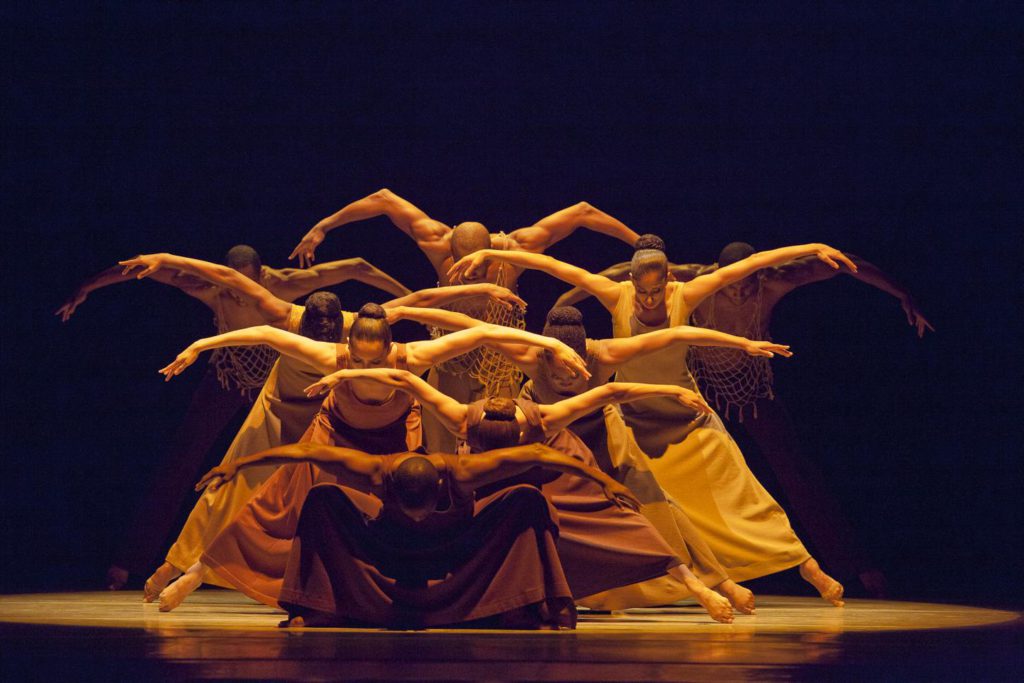 the world” – a simple, but strong sequence. We felt the heat of the glowing red sun and the onerous conditions of everyday life that the dancers portrayed. The white flags, the huge white parasol and the wide, floor-length white dresses the dancers sported didn’t indicate a summer outing in the countryside (similar to Marguerite and Armand’s stay at the country house in “Lady of the Camellias”), but were part of a joyous ceremonial baptism.
the world” – a simple, but strong sequence. We felt the heat of the glowing red sun and the onerous conditions of everyday life that the dancers portrayed. The white flags, the huge white parasol and the wide, floor-length white dresses the dancers sported didn’t indicate a summer outing in the countryside (similar to Marguerite and Armand’s stay at the country house in “Lady of the Camellias”), but were part of a joyous ceremonial baptism.
Contemplative sequences like the one to “I wanna be ready Lord” altered with cheerful ones. “Run to the Lord” had the dancers literally hurrying across the stage. They turned, jumped and struggled forward in every possible way. The final “Move, Members, Move” reminded one of a communal feast at a summer weekend. Everyone was in high spirits; a strong sense of togetherness spread; fans fluttered busily like butterfly wings. The ladies chatted, put the men in their places and everyone danced a lot.
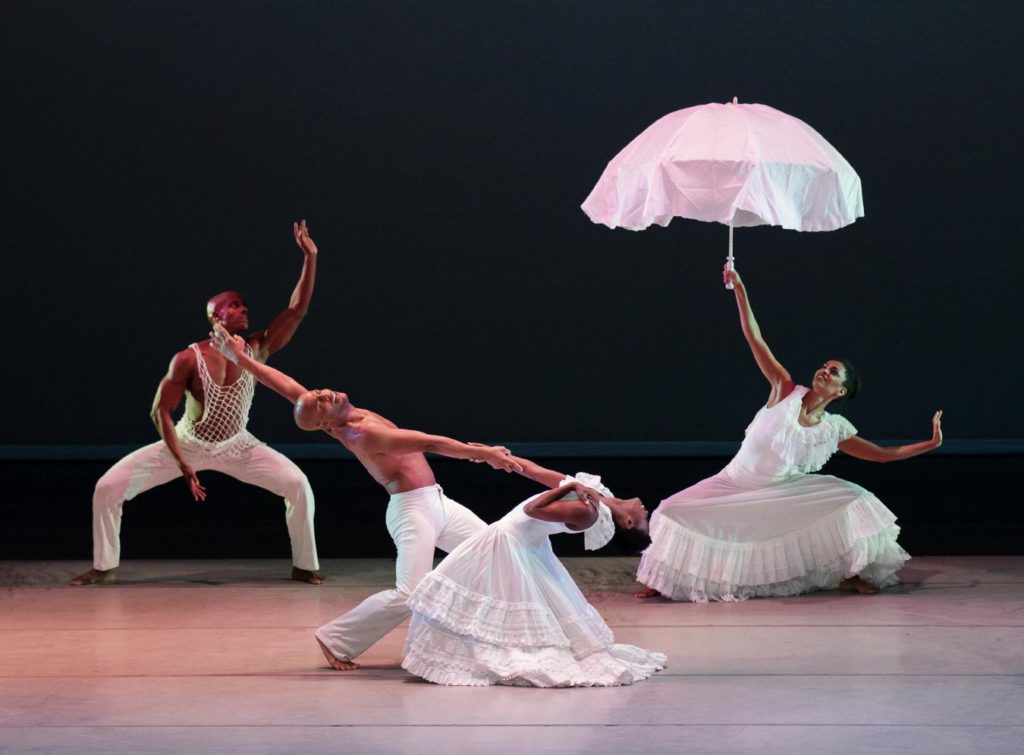 “Revelations” won much applause, but for two reasons it didn’t entirely click with the audience. First, the dancers hadn’t yet made the Munich stage their own. “Revelations” is at the heart of their repertory and as an appointed “Cultural Ambassador to the World” it seemed important for the company that the piece was well received. But they didn’t need to make the piece and themselves pleasant. It impairs their own power and the piece’s inherent one.
“Revelations” won much applause, but for two reasons it didn’t entirely click with the audience. First, the dancers hadn’t yet made the Munich stage their own. “Revelations” is at the heart of their repertory and as an appointed “Cultural Ambassador to the World” it seemed important for the company that the piece was well received. But they didn’t need to make the piece and themselves pleasant. It impairs their own power and the piece’s inherent one.
Secondly, “Revelations” is more than half a century old. Unlike other pieces it is not merely dance art, but dance charged with real history. As a member of a European audience, one cannot watch it impartially or even critically. Judging the history of another ethnic group wouldn’t be appropriate. Hence one doesn’t impulsively respond to the piece from the heart, but more from the mind. But bridging different cultures only works with the heart involved.
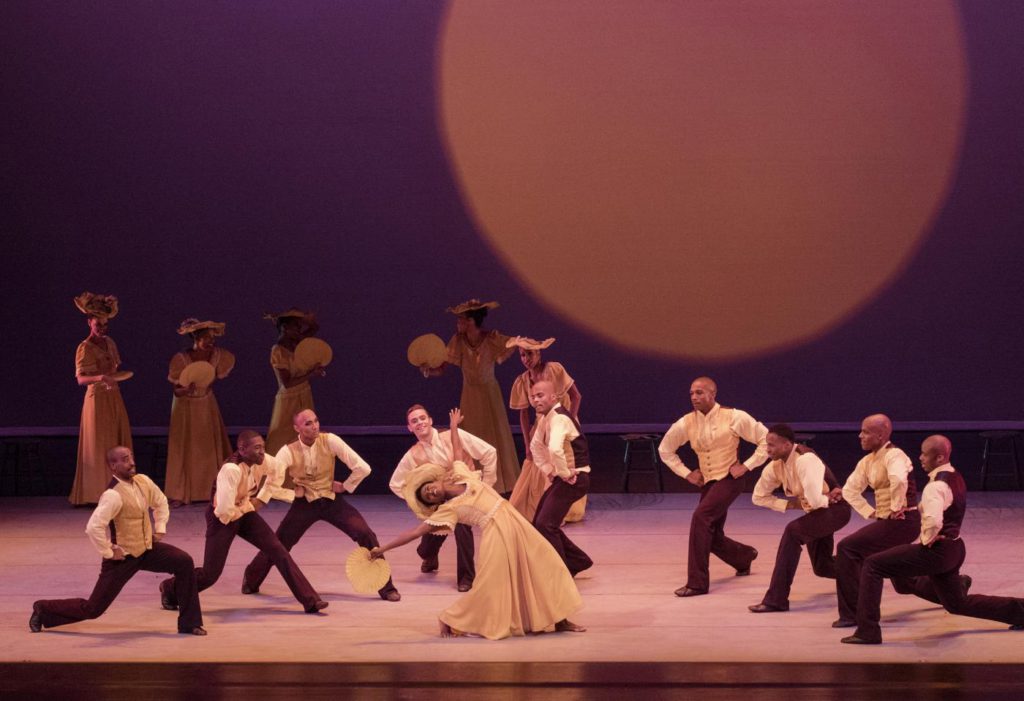
| Links: | Website of Alvin Ailey American Dance Theater | |
| Website of Deutsches Theater, Munich | ||
| Excerpt “Four Corners” (video) | ||
| Excerpt “Exodus” (video) | ||
| Excerpt “Takademe” (video) | ||
| Trailer “Revelations” (video) | ||
| Photos: | 1. | Belen Pereyra, “Four Corners” by Ronald K. Brown, Alvin Ailey American Dance Theater © Paul Kolnik |
| 2. | Belen Pereyra, Glenn Allen Sims, Linda Celeste Sims and Matthew Rushing, “Four Corners” by Ronald K. Brown, Alvin Ailey American Dance Theater © Christopher Duggan | |
| 3. | Ensemble, “Four Corners” by Ronald K. Brown, Alvin Ailey American Dance Theater © Paul Kolnik | |
| 4. | Ensemble, “Four Corners” by Ronald K. Brown, Alvin Ailey American Dance Theater © Paul Kolnik | |
| 5. | Jamar Roberts and ensemble, “Exodus” by Rennie Harris, Alvin Ailey American Dance Theater © Paul Kolnik | |
| 6. | Jamar Roberts, Hope Boykin and ensemble, “Exodus” by Rennie Harris, Alvin Ailey American Dance Theater © Paul Kolnik | |
| 7. | Ensemble, “Exodus” by Rennie Harris, Alvin Ailey American Dance Theater © Paul Kolnik | |
| 8. | Yannik Lebrun, “Takademe” by Robert Battle, Alvin Ailey American Dance Theater © Andrew Eccles | |
| 9. | Ensemble, “Revelations” by Alvin Ailey, Alvin Ailey American Dance Theater © Gert Krautbauer | |
| 10 | Linda Celeste Sims, Glenn Allen Sims and ensemble, “Revelations” by Alvin Ailey, Alvin Ailey American Dance Theater © Alvin Ailey American Dance Theater | |
| 11. | Ensemble, “Revelations” by Alvin Ailey, Alvin Ailey American Dance Theater © Alvin Ailey American Dance Theater | |
| Editing: | Laurence Smelser |
